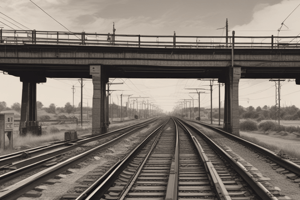Podcast
Questions and Answers
What is the significance of track gauge in railway infrastructure?
What is the significance of track gauge in railway infrastructure?
- It influences the safety of railway operations (correct)
- It affects the color of the trains
- It determines the speed of the trains
- It impacts the seating capacity of the trains
What was the major technological advancement that made railways a major mode of transportation in the 19th century?
What was the major technological advancement that made railways a major mode of transportation in the 19th century?
- Horse-drawn carriages
- Diesel engines
- Electric trains
- Steam locomotives (correct)
When was the first railway built near Stockton-on-Tees in England?
When was the first railway built near Stockton-on-Tees in England?
- 1567
- 1750
- 1661 (correct)
- 1845
What is the main purpose of different types of railway gauges like narrow gauge and broad gauge?
What is the main purpose of different types of railway gauges like narrow gauge and broad gauge?
Which century saw a rapid expansion of railways to meet the demand for transporting raw materials and finished goods?
Which century saw a rapid expansion of railways to meet the demand for transporting raw materials and finished goods?
What is the typical range for the width of broad gauge tracks?
What is the typical range for the width of broad gauge tracks?
Why have concrete sleepers gained popularity in recent years?
Why have concrete sleepers gained popularity in recent years?
Which high-speed train is mentioned as a demonstration of advanced engineering capabilities?
Which high-speed train is mentioned as a demonstration of advanced engineering capabilities?
How have electrification and renewable energy sources impacted railway transportation?
How have electrification and renewable energy sources impacted railway transportation?
Why are aluminum rails considered beneficial compared to steel rails?
Why are aluminum rails considered beneficial compared to steel rails?
Study Notes
Railway Transportation
Railway transportation is one of the most widespread and efficient modes of transport around the world, offering several benefits including reducing air pollution by replacing road traffic with trains, saving energy through its high load capacity, and providing a safe means of transportation. Railways have been used for over two centuries and continue to play a significant role in connecting cities, towns, and countries across the globe. In this article, we will focus on the subtopic of railway infrastructure.
History of Railway Infrastructure
The first railway was built near Stockton-on-Tees in England in 1661, using wooden rails set into stone blocks and pulled by horses. However, it wasn't until the 19th century, with the advent of steam locomotives, that railways became a major mode of transportation. During the Industrial Revolution, railways expanded rapidly to meet the need for transporting raw materials and finished goods. Over time, different types of railways emerged, such as narrow gauge, standard gauge, broad gauge, and metric gauge, each tailored to specific needs.
Types of Rail Infrastructure
Track Gauges
The width between the inner edges of the rails, known as the track gauge, is a crucial aspect of railway infrastructure. The most common types of track gauges are:
- Narrow Gauge: Tracks with a gauge less than 1 meter (3 feet 3 inches) are considered narrow gauge. They are often used for mountainous regions where regular tracks cannot reach due to steep inclines.
- Standard Gauge: With a track gauge between 1.4 meters and 1.6 meters (4 feet 7 inches and 5 feet 2 inches), standard gauges are the norm in many countries, enabling efficient train travel across vast distances.
- Broad Gauge: Wider than standard gauge, typically ranging from 1.6 meters to 2 meters (5 feet 2 inches to 6 feet 6 inches), broad gauge tracks were historically used for passenger trains, especially express services. Modern uses include freight lines in India, Australia, and South Africa.
- Metric Gauge: Also called narrow gauge, metric gauge tracks have a track gauge of less than 1.435 meters (4 feet 8 inches).
Rail Materials
There are various materials used for railway rails, including wrought iron, steel, concrete, and aluminum. Wrought iron rails, popular since the early days of railroads, have largely been replaced by steel due to its superior strength and durability. Concrete sleepers, also known as ties, have gained popularity in recent years due to their environmental benefits and lower maintenance requirements compared to traditional wood sleepers. Aluminum rails are another option, weighing a third of steel, which can reduce overall weight, improve fuel efficiency, and decrease stress on tracks.
Evolution of Railway Infrastructure
Over the past few decades, railway technology has evolved significantly, leading to improvements in speed, safety, and efficiency. High-speed trains like the Shinkansen in Japan and Maglev in China demonstrate advanced engineering capabilities, while digital signaling systems have enhanced communication between trains and stations. Additionally, electrification and renewable energy sources have reduced reliance on fossil fuels, contributing to a more sustainable future for railway transportation.
In conclusion, railway infrastructure plays a vital role in supporting the efficient movement of passengers and cargo worldwide. From the historical development of railways to the modern advancements in technology and materials, railway infrastructure continues to adapt and innovate, ensuring a reliable and environmentally friendly mode of transportation for generations to come.
Studying That Suits You
Use AI to generate personalized quizzes and flashcards to suit your learning preferences.
Description
Test your knowledge on the history, types, and materials of railway infrastructure with this quiz. Explore the evolution of railway technology, different track gauges, and materials used in rail construction.




